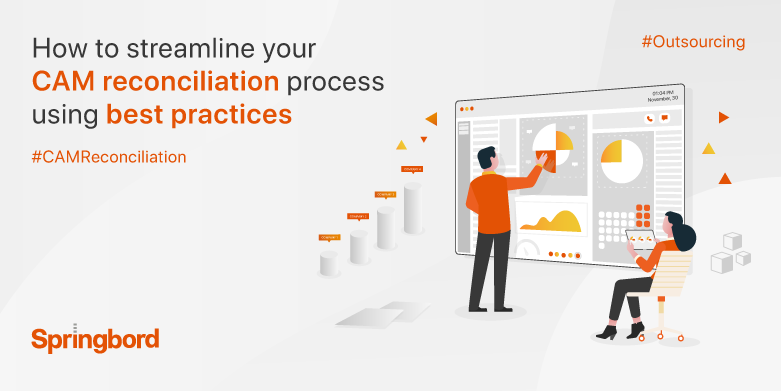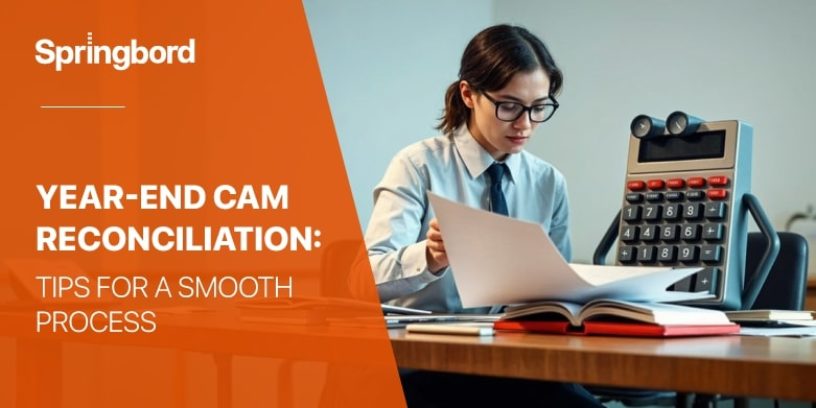 Read time 7 min
Read time 7 minCommon Area Maintenance (CAM) reconciliation is extremely important for business owners managing commercial properties.
This process ensures that tenant’s expenses incurred in maintaining shared spaces are fairly distributed according to their lease agreements.
Accurate CAM reconciliation promotes transparency, builds trust between landlords and tenants, and helps in efficient financial planning for both parties.
Significance of CAM Reconciliation
1. Financial Accuracy and Budgeting: Proper CAM reconciliation provides a clear picture of actual expenses versus estimated charges. This helps identify discrepancies, which is essential for accurate budgeting and financial planning.
2. Tenant-Landlord Trust: Transparent and accurate reconciliation statements build trust between landlords and tenants. Clear communication about how CAM charges are calculated and adjusted prevents disputes and fosters a positive relationship. Providing detailed breakdowns and being open to addressing tenant concerns is crucial for maintaining this trust.
3. Legal and Regulatory Compliance: Adhering to lease agreements and local regulations is imperative in CAM reconciliation. This ensures that all charges are justified and legally compliant, avoiding potential legal issues and financial penalties. Regular lease audits and thorough documentation help in maintaining compliance and financial accuracy.
Common Challenges in Year-End CAM Reconciliation
Year-end CAM reconciliation can be a complex and challenging process for property managers and business owners.
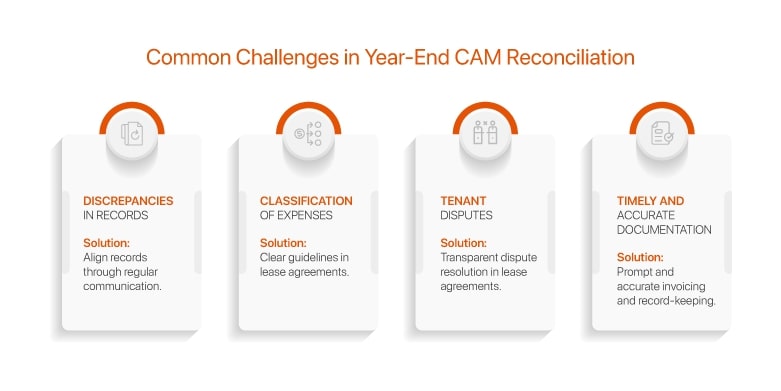
This critical task involves comparing estimated CAM charges with actual expenses incurred over the year, ensuring that all costs are fairly allocated among tenants.
Despite its importance, several common challenges can complicate the reconciliation process.
1. Discrepancies in Records: Maintaining accurate and consistent records throughout the year is challenging. Discrepancies between the landlord’s and tenant’s records can lead to disputes. Regular communication and collaborative efforts to align records can mitigate this issue.
2. Classification of Expenses: Distinguishing between operating expenses and capital expenditures can be complex. Misclassification can significantly impact CAM charges. Establishing clear guidelines in lease agreements and adhering to them is vital for correct expense categorization.
3. Tenant Disputes: Despite best efforts, disputes over CAM charges can arise. Having a transparent dispute resolution mechanism in place helps address these conflicts efficiently. This mechanism should be clearly defined in lease agreements to ensure a fair and timely resolution process.
4. Timely and Accurate Documentation: Timely invoicing and accurate documentation are essential for smooth reconciliation. Delays or inaccuracies can lead to financial losses and strained tenant relationships. Ensuring that all expenses are well-documented and invoices are issued promptly is crucial for a successful CAM reconciliation.
At Springbord, we specialize in providing comprehensive CAM reconciliation services that address these challenges head-on. Our expertise ensures accuracy, compliance, and efficiency in the reconciliation process, allowing business owners to focus on their core activities.
Preparation for Year-End Reconciliation
Effective preparation is crucial for a smooth year-end CAM reconciliation process.
By proactively addressing these areas, property managers can ensure accuracy, compliance, and a reduction in potential disputes during the reconciliation process.
Regular Audits and Record-Keeping
Conducting regular internal audits and maintaining meticulous records throughout the year are fundamental steps in ensuring a smooth year-end CAM reconciliation process. Regular audits help identify discrepancies early, allowing for timely corrections and adjustments.
This proactive approach can prevent significant financial losses and disputes with tenants. According to a study by the Institute of Internal Auditors, organizations that perform regular audits report a 30% reduction in financial discrepancies.
Key Practices for Effective Record Keeping:
- Consistent Documentation: Maintain detailed records of all CAM-related expenses, including invoices, receipts, and maintenance logs.
- Monthly Reviews: Perform monthly reviews of expenses to ensure they align with budgeted amounts and lease agreements.
- Audit Trails: Establish clear audit trails for all transactions to facilitate easy tracking and verification during the reconciliation process.
Expense Categorization
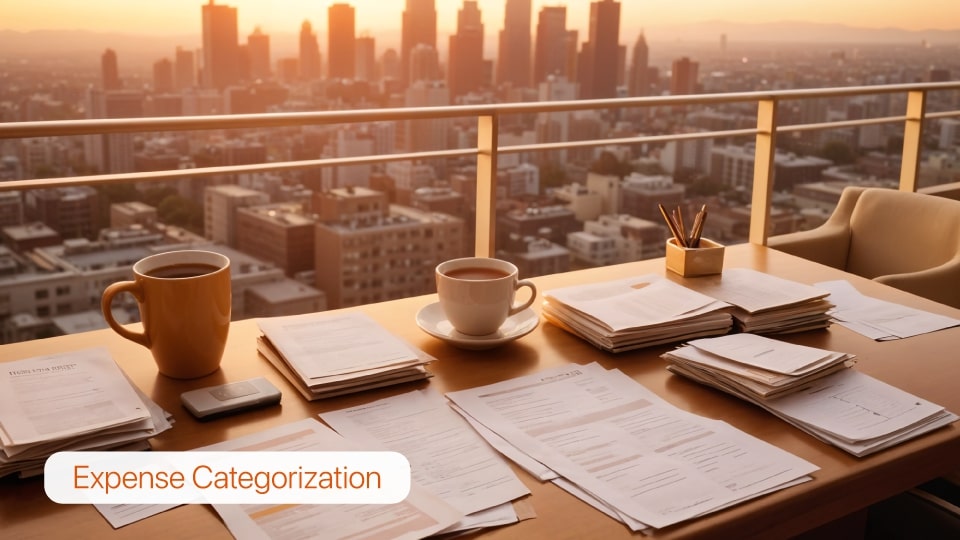
Proper expense categorization is important to avoid confusion and disputes during the CAM reconciliation process.
Misclassified expenses can lead to incorrect charges, tenant dissatisfaction, and potential legal issues.
Tips for Accurate Expense Categorization:
- Clear Definitions: Establish clear definitions for each category of expenses (e.g., maintenance, security, utilities, property management fees) in the lease agreements. This ensures both landlords and tenants have a mutual understanding of what constitutes each expense.
- Use Standardized Codes: Implement standardized coding systems for different types of expenses. This helps in consistent categorization and simplifies the reconciliation process.
- Regular Updates: Update expense categories regularly to reflect any changes in lease agreements or operational costs.
A report by Deloitte highlighted that accurate expense categorization can reduce reconciliation time by up to 25% and significantly decrease the likelihood of disputes.
Communication with Tenants
Transparent and regular communication with tenants regarding CAM charges is essential for building trust and avoiding disputes.
Keeping tenants informed about how their CAM charges are calculated and any adjustments made during the year fosters a cooperative relationship.
Best Practices for Effective Communication:
- Regular Updates: Provide tenants with regular updates on CAM expenses and any anticipated changes. This can be done through quarterly or semi-annual reports.
- Detailed Statements: Ensure that year-end reconciliation statements are detailed, clearly explaining each charge and any discrepancies between estimated and actual expenses.
- Open Channels: Maintain open channels of communication for tenants to ask questions and express concerns about their CAM charges. Promptly address any issues raised to prevent them from escalating into disputes.
Springbord assists property managers in achieving accurate and transparent CAM reconciliations by utilizing our innovative technology and industry expertise, which ultimately leads to better financial results and healthier tenant relationships.
Detailed Steps for a Smooth Reconciliation Process

A smooth year-end CAM reconciliation process is essential for maintaining financial transparency and trust between landlords and tenants.
This process involves several critical steps. Each step plays a vital role in ensuring that CAM charges are fair, justified, and transparent.
Gather and Review Documentation
The first step in the CAM reconciliation process is to gather all the necessary documentation.
This includes invoices, receipts, and records of CAM expenses incurred throughout the year. Meticulous record-keeping is crucial to ensuring that all expenses are accounted for accurately.
- Collecting Documentation: Ensure that all documents related to CAM expenses are collected. This includes maintenance invoices, utility bills, security service receipts, and property management fees.
- Verification: Verify the accuracy and completeness of the collected documentation. Cross-check these documents with internal records to identify any discrepancies. According to a study by the NAREIT, 65% of reconciliation errors stem from incomplete or inaccurate documentation.
Allocate Expenses
Accurate allocation of expenses according to lease agreements is essential to avoid disputes and ensure fairness.
- Expense Allocation: Allocate each expense item according to the terms specified in the lease agreements. Ensure that common area expenses are proportionately distributed among tenants based on their lease terms.
- Correct Categorization: Make sure all expenses are categorized correctly. Misclassification can lead to incorrect charges and potential disputes.
Calculate Tenant Share
Calculating each tenant’s share of CAM charges involves using an agreed-upon formula.
This step ensures that tenants are charged fairly based on their lease agreements.
- Using Formulas: Apply the agreed-upon formulas to determine each tenant’s share of CAM charges. Consider factors such as leasable area, actual usage, and any specific caps or exclusions outlined in the lease agreements.
- Consider All Factors: Ensure all relevant factors, such as tenant-specific adjustments or negotiated caps on CAM charges, are considered in the calculation.
Prepare Reconciliation Statements
Creating detailed reconciliation statements for each tenant is important for transparency and understanding.
- Detailed Breakdown: Prepare reconciliation statements that include a detailed breakdown of all expenses. Each statement should clearly show the calculations used to determine the tenant’s share.
- Transparency: Ensure that the statements are easy to understand, providing transparency and helping tenants see how their charges were calculated.
Audit and Verify
Conducting audits is a critical step to ensuring the accuracy of the reconciliation.
- Internal Audit: Perform an internal audit to verify the accuracy of the reconciliation. Check all calculations and ensure that all expenses are correctly allocated.
- External Audit: Consider hiring an external auditor to provide an unbiased review of the reconciliation. An external audit can help identify any overlooked errors and ensure compliance with industry standards. A study by the Institute of Internal Auditors found that external audits can reduce financial discrepancies by 30%.
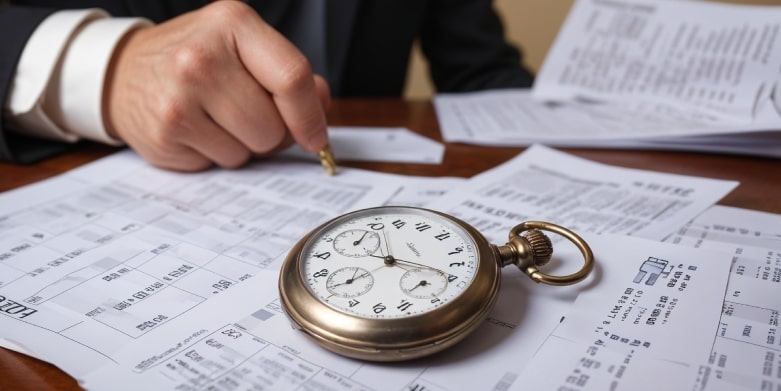
Communicate with Tenants
Effective communication with tenants about their CAM charges is essential for maintaining positive relationships and preventing disputes.
- Prompt Communication: Send the reconciliation statements to tenants promptly after completing the reconciliation process.
- Clear Explanations: Provide a clear explanation of the charges, including any adjustments made during the reconciliation. Be ready to answer any queries or worries that tenants might have.
Handle Disputes Professionally
Disputes may arise during the CAM reconciliation process. Handling them professionally and proactively is crucial.
- Proactive Resolution: Address disputes promptly by providing evidence and clear explanations. Aim to resolve issues amicably through transparent communication.
- Mediation and Legal Advice: If disputes cannot be resolved through direct communication, consider mediation or seek legal advice to ensure a fair and timely resolution.
Springbord excels in providing comprehensive CAM reconciliation services, ensuring accuracy, transparency, and compliance throughout the process.
Our team specializes in meticulous documentation, precise expense categorization, and effective communication, helping landlords and property managers achieve smooth and efficient reconciliations.
Conclusion
A smooth year-end CAM reconciliation process is crucial for maintaining financial transparency, compliance, and trust between landlords and tenants.
By addressing common challenges, preparing effectively, and following detailed reconciliation steps, property managers can ensure fair and accurate distribution of CAM charges. Regular audits, meticulous record-keeping, accurate expense categorization, and clear communication are essential components of this process.
Ensure your CAM reconciliation process is seamless and accurate with Springbord’s expert services.
Partner with Springbord to enhance your property management operations and achieve better financial outcomes. For more information about our all-inclusive CAM reconciliation services and how we can help your company, contact Springbord right now.





